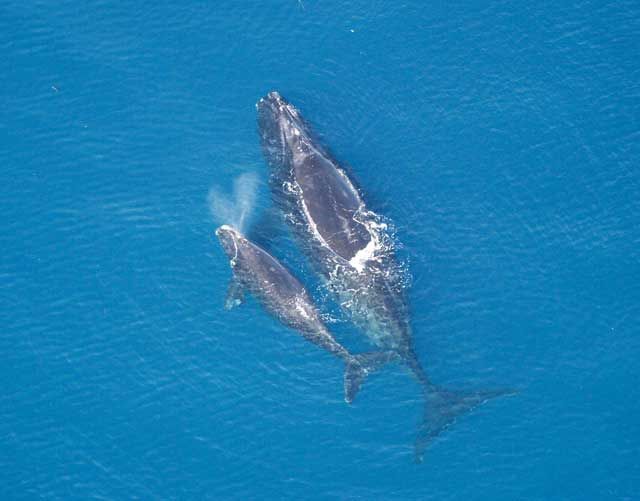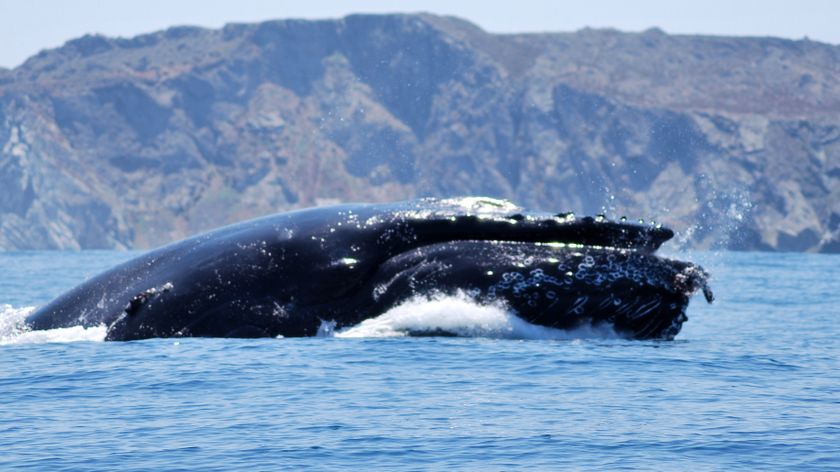Sightings May Solve Whale of a Mystery

A large number of North Atlantic right whales have been spotted recently in the ocean off New England, suggesting a rare, potential wintering and breeding ground for the endangered marine mammals, researchers say.
If confirmed, this could solve the mystery of where some of these whales spend winter.
Right whales can weigh up to 100 tons. They got their name from whalers who thought the animals were the "right" ones to hunt, because they floated when killed and could be spotted swimming in waters near the shore. North Atlantic right whales are listed under the Endangered Species Act. Right whales are the rarest of all large whale species and among the rarest of all marine mammal species, according to the National Oceanic and Atmospheric Administration.
An aerial survey team with NOAA's Northeast Fisheries Science Center (NEFSC) saw 44 individual right whales on Dec. 3 in the Jordan Basin area, about 70 miles south of Bar Harbor, Maine. Weather permitting, the team regularly surveys the waters from Maine to Long Island and offshore 150 miles to the Hague Line (the U.S.-Canadian border). {{ video="LS_090204_whale" title="A Surprising Whale Discovery" caption="A paleontologist describes his discovery of the remains of an extinct mother whale with her fetus still in the womb." }} "We're excited because seeing 44 right whales together in the Gulf of Maine is a record for the winter months, when daily observations of 3 or 5 animals are much more common," said Tim Cole, who heads the team.
"Right whales are baleen whales, and in the winter spend a lot of time diving for food deep in the water column. Seeing so many of them at the surface when we are flying over an area is a bit of luck."
Baleen whales filter their food from water through plates of baleen in their mouths, rather than using teeth. The Gulf of Maine includes the ocean waters that lap around between Cape Cod in Massachusetts and the southern tip of Cape Sable in Nova Scotia, Canada. More December sightings
Just a few days later, on Dec. 6, the team observed only three right whales on Cashes Ledge, about 80 miles east of Gloucester, Mass. Cole says the whales are known to be in the region, but actually seeing any of them on any given aerial survey is unpredictable. On Dec. 14, the team saw 41 right whales just west of Jordan Basin. Many female North Atlantic right whales head south in winter to give birth in the waters off Florida and Georgia, the only known calving ground for this population. Little is known about where other individual right whales go in winter, largely due to surveying conditions. Bad weather, the challenges of finding whales in such a large area, and the resources required to assess their distribution make sightings in winter especially difficult. The aerial surveys, conducted year-round, began in the 1990s. "Sometimes we will see a whale we haven't seen in years, while other individuals are sighted fairly often," team member Pete Duley said, noting the existing library of photographs of individual right whales that observers have come to know by name based on the patterns of callosities, like barnacles, on the animal's heads.
Sign up for the Live Science daily newsletter now
Get the world’s most fascinating discoveries delivered straight to your inbox.
"Because only about 100 right whales, mostly females and their calves, are sighted each year in aerial surveys off the southeast coast, we know the remainder of the population must be somewhere else. We don't know much about where these other whales spend the winter or breed, but we have recently started to look in the Gulf of Maine in winter." Efforts to protect whales
With a population estimated to be about 325 whales, knowing where the North Atlantic right whales are at any time is critical to protecting them. Finding an aggregation of whales can trigger a management action affording protection, such as slowing ship speeds in the vicinity of the whales.
On Dec. 9, new federal speed rules for large ships went into effect to reduce ship strikes of whales, to which North Atlantic right whales are particularly vulnerable. Since the National Marine Fisheries Service, also known as NOAA Fisheries Service, has federal responsibilities for right whales and other marine mammals under the Marine Mammal Protection Act and Endangered Species Act, the NEFSC is a primary source of information about North Atlantic right whales in the northeast region. The Center conducts scientific research, while the agency's regional office in Gloucester handles policy and regulatory issues. The aerial survey team is part of the NEFSC's Protected Species Branch based at the Center's Woods Hole Laboratory, which conducts research needed to manage protected species off the northeast coast of the U.S. from Maine to North Carolina.
"We regularly exchange information with our colleagues in the southeast, who are currently doing aerial surveys of the right whales now in that region, so we know which whales are there over the winter based on their sightings and can track births," said Allison Glass, another member of the NEFSC survey team. Glass and other team members, who are marine biologists, have flown surveys and worked in the southeast region as well, so they know the individual animals. Team members carry a pager to keep up to date on right whale sightings. When a sighting is reported, the maritime community is immediately notified via email, a sighting Web site and other automated means. Twin Otter now used for survey The survey team has used a variety of aircraft through the years, from helicopters to seaplanes to the current Twin Otter based at the nearby U.S. Coast Guard Air Station Cape Cod.
On each flight, which generally lasts five to six hours, there are two pilots for safety, two observers and a data recorder. Special domed or "bubble" windows on each side of the aircraft permit each observer to scan a wide range of ocean surface. A removable window in the back of the plane allows them to take clear photographs of any right whales they see.
Other species of whales and marine mammals sighted are recorded into the data logging system but are not individually photographed. Only right whales are uniquely suited for individual identification from the air. In early January, several colleagues from the Woods Hole Laboratory will head south to continue genetic sampling and tagging studies of right whales off of Florida. During the last three calving seasons, marine mammal scientists have collected small samples of skin and blubber from newborns and adults who have not been previously sampled to track the population through genetic "fingerprinting."
- Video – Gray Whale Population Takes a Dive
- Gallery: Under the Sea
- Top 10 Biggest Beasts












